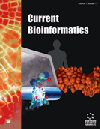- Home
- A-Z Publications
- Current Bioinformatics
- Previous Issues
- Volume 17, Issue 6, 2022
Current Bioinformatics - Volume 17, Issue 6, 2022
Volume 17, Issue 6, 2022
-
-
Graph Neural Networks in Biomedical Data: A Review
More LessAuthors: You Li, Guiyang Zhang, Pan Wang, Zuo-Guo Yu and Guohua HuangWith the development of sequencing technology, various forms of biomedical data, including genomics, transcriptomics, proteomics, microbiomics, and metabolomics data, are increasingly emerging. These data are an external manifestation of cell activity and mechanism. How to deeply analyze these data is critical to uncovering and understanding the nature of life. Due to the heterogeneousness and complexity of these Read More
-
-
-
Structural Biology Meets Biomolecular Networks: The Post-AlphaFold Era
More LessAuthors: Wenying Yan and Guang HuBackground: Recent progress in protein structure prediction by AlphaFold has opened new avenues to decipher biological functions from the perspective of structural biology based on the proteomics level. Methods: To meet these challenges, in this perspective, three scales of networks for protein structures, including structural protein-protein networks, protein structural networks, and elastic network models were introduce Read More
-
-
-
Identifying Biomarkers of Cisplatin Sensitivity in Non-Small Cell Lung Cancer via Comprehensive Integrative Analysis
More LessAuthors: Xin-Ping Xie, Wulin Yang, Lei Zhang and Hong-Qiang WangBackground: Only 30-40% of non-small cell lung cancer (NSCLC) patients are clinically sensitive to cisplatin-based chemotherapy. Thus, it is necessary to identify biomarkers for personalized cisplatin chemotherapy in NSCLC. However, data heterogeneity and low-value density make it challenging to detect reliable cisplatin efficacy biomarkers using traditional analysis methods. Objective: This paper aims to find reliable Read More
-
-
-
Comprehensive Analysis of the Differentially Expressed Transcriptome with ceRNA Networks in a Mouse Model of Liver Cirrhosis
More LessAuthors: Yichi Zhang, Xinsheng Nie, Yanan Jiang, Lijuan Wang, Zhuzhi Wan, Hao Jin, Ronghui Pu, Meihui Liang, Hailong Zhang, Qi Liu, Yuan Chang, Yang Gao, Ningning Yang and Shizhu JinBackground: Hepatic cirrhosis is the consequence of various chronic liver diseases for which there is no curative treatment. In this study, based on RNA sequencing (RNA-seq) and subsequent bioinformatic analysis, we aim to explore the biological function of non-coding RNAs (ncRNAs) in hepatic cirrhosis. Methods: The hepatic cirrhosis models were induced by the intraperitoneal injection of carbon tetrachloride (CCl4). The transcr Read More
-
-
-
A Simple and Practical microRNA-based Nomogram to Predict Metastatic HCC
More LessAuthors: Yong Zhu, Yusheng Jie, Yuankai Wu, Wenting Tang, Jing Cao, Zhongzhen Su, Zhenjian Zhuo, Jiao Gong and Yutian ChongBackground: Despite unprecedented scientific progress that has been achieved over the years, there is no established microRNA-based model for predicting hepatocellular carcinoma (HCC) metastasis. To this end, we aimed to develop a simple model based on the expression of miRNAs to identify patients at high risk of metastatic HCC. Methods: HCC datasets with metastasis data were acquired from the Gene Expression O Read More
-
-
-
AthEDL: Identifying Enhancers in Arabidopsis thaliana Using an Attention-based Deep Learning Method
More LessAuthors: Yiqiong Chen, Yujia Gao, Hejie Zhou, Yanming Zuo, Youhua Zhang and Zhenyu YueBackground: Enhancers are key cis-function elements of DNA structure that are crucial in gene regulation and the function of a promoter in eukaryotic cells. Availability of accurate identification of the enhancers would facilitate the understanding of DNA functions and their physiological roles. Previous studies have revealed the effectiveness of computational methods for identifying enhancers in other organisms. To date, Read More
-
-
-
Chronological Order Based Wrapper Technique for Drug-Target Interaction Prediction (CO-WT DTI)
More LessAuthors: Kavipriya Gananathan, Manjula Dhanabalachandran and Vijayan SugumaranBackground: Drug-Target Interactions (DTIs) are used to suggest new medications for diseases or reuse existing drugs to treat other diseases since experimental procedures take years to complete, and FDA (Food and Drug Administration) permission is necessary for drugs to be made available in the market. Objective: Computational methods are favoured over wet-lab experiments in drug analysis, considering that the process i Read More
-
Volumes & issues
-
Volume 20 (2025)
-
Volume 19 (2024)
-
Volume 18 (2023)
-
Volume 17 (2022)
-
Volume 16 (2021)
-
Volume 15 (2020)
-
Volume 14 (2019)
-
Volume 13 (2018)
-
Volume 12 (2017)
-
Volume 11 (2016)
-
Volume 10 (2015)
-
Volume 9 (2014)
-
Volume 8 (2013)
-
Volume 7 (2012)
-
Volume 6 (2011)
-
Volume 5 (2010)
-
Volume 4 (2009)
-
Volume 3 (2008)
-
Volume 2 (2007)
-
Volume 1 (2006)
Most Read This Month
Article
content/journals/cbio
Journal
10
5
false
en


